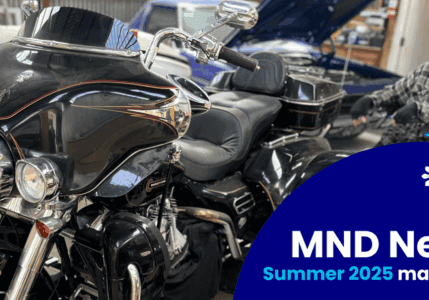2018 Research Update: Drug Development
Research
25 July 2018

A summary of research from the 2018 Australasian MND Symposium.
This information will be of interest to neurologists and researchers with an interest in MND, and people affected by MND who have a strong interest in scientific research.
This update discusses the early 2018 drug development pipeline and our current understanding of the disease mechanisms in MND.
- For an easier to read format, please click here for a PDF of the text below.
1. Drug Development
Overview
ALS is not one disease. Will not be solved by one treatment. Genetics discoveries point to the pathways for
disease.
18 clinical trials have failed in the last decade. Failure in clinical trials is a problem, shared with other
neurodegenerative disease research. Better disease modelling and better understanding of disease
mechanisms will help.
Everyone is extremely optimistic about antisense oligonucleotide therapies (ASOs) for familial MND (SOD1
and C9orf72). Clinical trials beginning this year. Success treating SMA in 2016/17 gives great hope for MND.
Predictions for success in treating SOD1- and C9ORF72-related MND with ASOs range from 5-10 years.
In future, ASOs could be delivered orally (peptide-assisted delivery), or could be new morpholino antisense
oligonucleotide (PMO) therapeutics. ASOs could also be useful for sporadic ALS – lowering ataxin 2.
Several other drug development avenues are being explored and any one could have a big impact.
“I believe that immunotherapy has great promise for MND.” – Prof Robert Henderson.
People with fast progressing MND have higher inflammation. Regulatory T cells correlate with a slower rate
of disease progression.
Whatever causes MND results in misfolded proteins, which triggers an immune response, which causes
inflammation, which causes damage to functional cells.
Cell stress leads to motor neuron death leads to motor function loss.
Motor neurons don’t die alone. Motor neuron death is non-cell autonomous, depends on a wellorchestrated
dialog involving neurons, glia and T cells.
Higher cortical hyperexcitability is related to a shorter life-span; could help early diagnosis or be useful as a
biomarker.
Spinal cord in ALS shows breakdown of blood-spinal cord barrier (BSCB). We need to understand better
what is going on at BSCB and BBB with MND – permeability, transporters.
TDP43 gives us a target common to almost everyone with MND. TDP43 aggregates correlates with motor neuron death.
Opportunities and advances in drug development for ALS/MND
Dr Lucie Bruijn, Chief Scientist, ALS Association, USA
Three drugs approved for ALS. Rilutek and Radicava are disease modifying. Neudexta provides
pseudobulbar affect symptom relief.
Explore therapeutics approaches as any one could make a big impact on ALS
- small molecules
- antisense therapy
- biologics (stem cells, antibodies, gene therapy)
Most promising targets are:
- SOD1 mutations – 2% of ALS
- C9orf72 – 10% of ALS
- TDP43 – almost all cases of ALS
Biggest challenge is that ALS is not one disease. Like the cancers it is a heterogeneous population.
Do we think it can be solved by one treatment? I think we all agree that this is not the case.
Failure in clinical trials not unique to ALS but shared with neurodegenerative diseases. Are we
looking at correct target? Are we administering in the correct time frame?
Other bottlenecks: disease modelling, biomarkers, clinical trial design
Mouse models help us understand complexity of the disease. Dog model is also being widely used
to test gene therapy and antisense – to help solves the problem in dogs too.
Biomarker discovery improves diagnosis, helps stratify clinical trials.
www.alsa.org/research/clinical-trials/
Antisense therapy & ALS Association funding:
- Antisense oligonucleotide (ASOs) therapy prevents the production of proteins in genes.
- In second clinical trial for SOD1, C9orf72 trial starting any day.
- The ALS Association has been supporting antisense therapy since 2004. From investment of $1.5
million, this mobilised an additional $100 million in research funds from industry. - ALS Association funding leads to much more significant (x200) industry funding.
- ALS Association now has many industry partnerships (GSK, Ionis)
- ALS Association was fortunate to receive a significant boost to funding in a small time frame (Ice
Bucket!). - Best to seed fund small areas
- Genetics discoveries point to the pathways for disease.
- ALS Association has committed to investing in large data – clinical and environmental information.
Really need to understand more about the whole of a person living with MND and not aspects in
isolation. - Why fund similar initiatives? Many came from different angles and bring unique opportunities.
GENE SILENCING / ANTISENSE THERAPY
Gene silencing therapy for ALS and beyond
Prof Don Cleveland
Ludwig Institute and Dept Cellular and Molecular Medicine, University of California San Diego, USA
Development of “designer DNA” drugs about to be in trial for ALS.
First causative gene discovered in 1993 – SOD1. When mouse model created, led to worldwide
agreement that mutations provoke disease through a toxic property, not loss of activity.
We think SOD1 is in every cell. By silencing it in motor neurons, get disease later. Deleted in
astrocytes, mice lived twice as long. Deleted in microglia, lived three times as long. Deleted from
oligodendrocytes, delayed onset. Conclusion that disease is non-cell autonomous, SOD1 within
motor neurons and oligodendrocytes drive onset.
Led to gene silencing therapy: antisense oligonucleotides (ASOs). Strategy started in 1990s, failed
many times. Current version of oligonucleotides bind to RNAs.
Strategy for ASO delivery = inject directly into cerebral spinal fluid, so crosses BBB.
Inject at onset, you double survival after onset.
C9ORF72: Largest cause of inherited MND and FTD discovered Sept 2011. Create mice that express
c9 expansion. Mice develop FTD-like behavioural abnormalities but not MND.
What happens if lower c9 levels? Not much in nervous system. Loss of function of c9 associated
with gain of toxicity. Have to lower the bad RNA but not the good RNA.
Injecting single dose of ASO lowers RNA level in c9 mice. Did it before disease onset, one dose,
suppressed acquisition of cognitive phenotype with a single dose.
Targets sense strand RNA (not antisense) because can’t measure antisense.
When people diagnosed, already have RNA toxicity. If you can turn down RNA, you turn down
translation product. You won’t get dead nerons back but have a chance of getting damaged
neurons back.
Expecting to get to human trial in second quarter 2018 – just 6.5 years after the gene was
discovered!
ALS Association invested right from the beginning when no-one else would. Was not initiated with
corporate money.
Success in other neurodegenerative diseases: ASOs will be widely used in other neurodegenerative conditions also. It’s possible to silence any gene we have tested to 95%.
- Huntington’s disease: Reduce mutant huntingtin synthesis in cells = long-term, partial disease reversal in mice, stopping further loss of brain mass in another mouse model. Sustained gene suppression throughout the nervous system after ASO injection at base of spinal cord. Single dose injection led to 3-month efficacy of target mRNA suppression. Ionis partnered with Roche for first trial in July 2015. Found safe and successfully lowered mutant huntingtin in Dec 2017.
- Spinal muscular atrophy (SMA):naffects one in 90,000 children.2016 ASO injection trial stopped at halfway point because all efficacy endpoints were met. Spinraza (for SMA) injected intrathecal injection (in babies – highly invasive).
- Alzheimers: A clinical trial of ASO therapy to lower tau launched in 2017.
10-year predictions:
- ALS and FTD – lowering c9 (2Q, 2018)
- sporadic ALS – lowering ataxin 2
- spinal cerebellar ataxias – lowering mutant ataxins
- chronic brain injury – lowering tau
- Parkinson’s – lowering alpha-synuclein
- AD – lowering tau
- glioblastoma – lower cell growth genes
- CNS delivery of oligonucleotide for treatment of neurodegenerative diseases
Fazel Shabanpoor
Florey Institute of Neuroscience, Australia
How can we deliver antisense oligonucleotides (ASOs)? Development of peptides as a delivery
vector.
ASOs are a single string of nucleic acids, interfere with gene expression by altering RNA function.
Approved for SMA, Duchene Muscular Dystrophy, Huntington’s, ALS (SOD1, C9). Also in clinical trial
for cancer. Really useful technology.
All treatments so far require large doses, repeating dosing, invasive injections. Require repeat
doses because big, bulky molecules. Need to cross BBB, neuronal cell membrane.
Other vectors for delivery:
- nanoparticles
- liposome
- antibodies
- peptides
Peptide-assisted delivery of ASOs: easy to synthesise and modify, more selective targeting, low
cost of manufacturing. Downsides: short half-life.
Peptide ASO – what would the final product look like? A daily dose? If can improve half-life to 1-2
hours that determines dosing. Won’t have to do it every day.
Genomic structural variations in ALS genomic regions
Prof Anthony Akkari
Head MND Genetics and Therapeutics Research, Perron Institute, Australia
Currently only 2 therapeutics approved for MND that have a limited effect (riluzole and edaravone).
18 clinical trials have failed in the last decade alone.
We have no diagnostics to predict who will respond to the drug and how to select those patients.
Working on developing new morpholino antisense oligonucleotide (PMO) therapeutics and novel
biomarkers called structural variations (SVs) that improve chances of success.
PMO therapeutics are suitable for a proportion of ALS patients. A PMO drug developed for
Duchenne Muscular Dystrophy received FDA approval in 2016.
High failure rate will continue if we continue using past approaches to ALS therapeutics
development. Antisense oligonucleotide technologies are essential.
NEUROINFLAMMATION
Suppressing neuroinflammation – cell-based therapy
Prof Stanley Appel, Houston Methodist Neurological Institute, USA
Each time a new gene is implicated in MND, it gives us a new process that might be impaired. As
you look at each process, you see that cells seek ‘help’ from other cells. Signalling beyond the
motor neuron contributes to the cell’s death, because it appears motor neurons don’t die alone.
In early stage MND, neuroprotective M2 microglia and T-reg lymphocytes slow disease progression.
As disease accelerates: motor neurons release ‘danger signals’ that promote microglial activation to
M1 proinflammatory state, downregulate neuroprotective T-regs, upregulate proinflammatory Th1
lymphocytes. This accelerates disease progression.
In a mouse model of mSOD1 ALS, there are slow and fast progressing types. The fast progressing
have higher inflammation.
T-cells suppress neuroinflammation in the mouse model. In humans, regulatory T cells (T-regs)
correlate with a slower rate of disease progression in pwMND. These “T-regs” are protective in
pwMND.
FoxP3 cells are also dysfunctional in pwMND.
Total immunosuppression doesn’t work. You need to change the ratio of “bad guys” to “good
guys”, to increase the regulatory T cells.
Infusions of patients own T-regs on 3 pwMND normalised the rate of progression. Doing it again 16
weeks later (once a month for four months) again stabilised progression. Progression increased
after treatment stopped (possible disease acceleration). So this was a positive result but not an
effective long-term therapy because it lasted only 2-6 weeks. Only 3 patients so far and not placebo
controlled.
Prof Stanley Appel says pilot study has shown that cell-based therapy to suppress
neuroinflammation is safe & well-tolerated: infusions of autologous T-reg cells restore immune
cell function.
A placebo controlled trial is now planned for six months, with dose escalation and infusions for one
year.
Associate Professor Anthony White
QIMR Berghofer Medical Research Institute, Australia
Neuroinflammation is a major contributor to MND, largely mediated by microglia, an immune cell
of the CNS
Microglia are brain macrophages that enter our brain in the embryonic stage. They respond to cell
death. The c9orf72 region is important to microglial cells.
Microglial targeted drugs have not yet translated into successful clinical outcomes. This is because
there are differences between animal and human microglia, and microglia are highly sensitive to
their local environment.
To overcome these issue we are establishing a new cell model of human microglia generated from
human peripheral blood monocytes (hiMG)
John Lee
Schol of Biomedical Sciences, University of Queensland
The complement system is an innate immune system, a component of blood.
C5a and C5aR1 are the most potent inflammatory mediators. The C5aR1 protein increases in the
microglia in the spinal cord of SOD1 mice in the later stages of MND.
In mice, the genetic absence of C5aR1 increased survival and improved motor function. The C5aR1
protein can also be knocked out in a mouse model with an irreversible drug – PMX205 – that can be
taken orally and crosses the blood-brain barrier. The PMX205 treatment improved muscle strength.
They also collected blood from pwMND and showed that C5a levels were elevated in plasma and
leukocytes. C5aR1 is also elevated in pwMND monocyte populations.
Prof Luis Berbeito
Institut Pasteur de Montvideo, Uruguay
Masitinib is a drug that is currently in clinical trials for asthma, MS, AD and ALS.
It targets mast cells. It can control microphages and microglia.
Mast cells infiltrate the muscles of humans with MND. Masitinib prevents this mast cell and
macrophage infiltration into muscles in rats with ALS.
There is hope for this drug class (tyrosine kinase inhibitors) for slowing MND progression.
STEM CELLS
Stem cells in MND research and treatment – an update
Prof Kevin Eggan
Dept of Stem Cell and Regenerative Biology, Harvard University; Director of the Stem Cell Program, Broad Institute, USA
Stem cells can differentiate into other types of cell. There are many types of stem cells. There are
already many effective stem cell therapies eg bone marrow transplants.
“Mesenchymal” stem cells derived from fibroblasts are the basis of the Brainstorm/NurOwn trial,
injected into ALS patients.
What are the oldest cells in your body? Neurons in your nervous system. Neurons don’t replicate
themselves. Substantial ramifications for how brain repairs itself. Once a neuron becomes
differentiated, it will never replace.
2. Disease Models and Mechanisms
GENETICS
How repeats get translated in c9orf72 ALS
Prof Peter Todd , University of Michigan Medical School, USA
A repeat expansion of the gene C9orf72 triggers the production of toxic proteins by a process
known as Repeat Associated Non-AUG (RAN) translation.
Have C9orf72 repeat when born, may get bigger over life, what drives penetrance when get to be
50 or 60 or 70? Stress could be a driver.
When cells undergo stresses (viral, oxidative, nutrient limitation etc), triggers stress granule
formation (toxic proteins).
RAN translation of C9ORF72 proteins kills neurones and causes neurodegeneration.
Further research is needed to identify methods of blocking the RAN translation of C9ORF72 as a
therapy and therefore stopping neurodegeneration.
This type of RAN translation happens in other repeat expansion diseases. If you develop a drug
that blocks this, you have a drug that can block multiple neurodegenerative diseases.
CORTICAL DYSFUNCTION/HYPEREXCITABILITY
Cortical dysfunction identifies regions of onset in ALS
Thanuja Dharmadasa, University of Sydeny
The hand is the most common site of onset of ALS – it’s a vulnerable area for neurodegeneration
because it’s so highly evolved.
Bulbar-onset patients show the greatest degree of cortical dysfunction (cortical hyperexcitability).
Prof Dharmadasa measured cortical hyperexcitability using MRI across all four limbs.
Measuring early cortical dysfunction marks the onset region and differences in the prognosis. This
suggests that higher cortical hyperexcitability is related to a shorter life-span.
Prominent cortical hyperexcitability was found in hand region of the motor cortex across all MND
subgroups. The hand is the most commonly reported onset site in ALS. Is the hand a critical trigger
in MND pathogenesis?
PLS type do not show any cortical hyperexcitability.
Cortical hyperexcitability is a focal phenomenon associated with a discreet area of onset.
Opportunity to apply regional therapies to stop spread.
Findings could be a useful prognosis biomarker and therapy approach aimed at modifying /reducing
cortical hyperexcitability.
Mehdi van den Bos
Westmead Hospital, Australia
Cortical hyperexcitability is a key point in the cascade of neuronal death.
Probing using Transcranial Magnetic Stimulation found that short intracortical inhibition (SICI) and
short intracortical facilitation (SICF) shift towards and excitary state early in the disease.
Findings could help early diagnosis of cortical dysfunction or be useful as a biomarker.
BLOOD-BRAIN BARRIER / BLOOD-SPINAL CORD BARRIER
Loss of blood-spinal cord barrier integrity displays regional patterning in ALS
Emma Scotter, University of Auckland, NZ
TDP43 gives us a target common to almost everyone with MND. Deposits in brain, spinal cord. All
NZ banked MND brains have TDP43 in motor cortex.
TDP43 aggregates correlates with motor neuron death. Map TDp43 across spinal cord, maps
against hot spots of motor neuron loss.
Breakdown of blood-spinal cord barrier (BSCB) might worsen outcomes for pwMND. Spinal cord in
ALS shows BSCB disturbance. Neurotoxic blood components found in cord. Proposed to be a
mechanism that may influence course of ALS.
We don’t yet know what is causing this leakage in the spinal cord. Probably some deficit in microcirculation.
Speculate that BSCB leakage develops and resolves first in the cervical and lumbar cord,
persisting in the thoracic cord at the end of life.
Thank you to the people who donated brain and spinal cord to our research.
The blood-brain barrier: An obstacle for CNS drug delivery impacted by MND
Dr Joseph Nicolazzo, Monash Institute of Pharmceutical Sciences
Overview of factors affecting transport of therapeutics across the blood-brain barrier (BBB).
About 640km of micro-vessels in the brain. Endothelial cells surround these, creating the BBB, or
‘neuro-vascular unit’. In a healthy BBB, movement between these cells is impossible. Proteins are
very well organised and have tight junctions.
It’s not impossible for molecules to get into the brain. Some transporters take glucose and other
small endogenous molecules across. Peptides, antibodies can also be trafficked across the BBB (like
insulin). Many scientists trying to get drugs to mimic these to get large molecules across the BBB –
if changing structure of the drug doesn’t change its efficacy.
Could MND have an impact on BBB transport of drugs? Blood has been found in spinal cord of
pwMND. Suggestive of paracellular permeability and dysfunctional tight junctions. If large
molecules detected in brain of pwMND could mean improved uptake of large molecule drugs.
Need to be mindful of co-existing conditions, non-MND drugs could start to go into brain. Concern
from pharamacological perspective.
We need to understand better what is going on at BBB with MND – permeability, transporters


